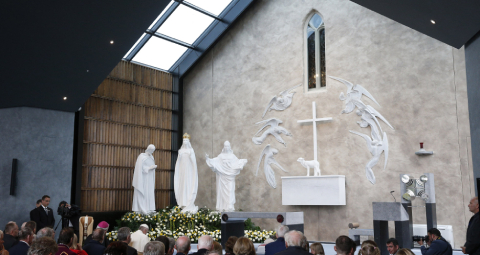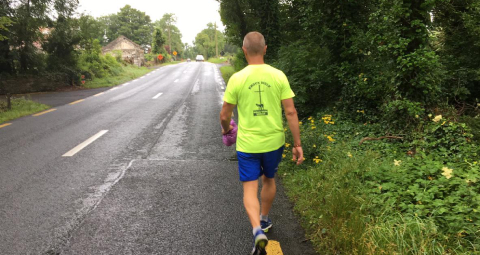September 6 | ![]() 0 COMMENTS
0 COMMENTS ![]() print
print

Knock pilgrimage, though arduous, bears many fruits for Scottish Catholics
Joe Bradley reveals his third pilgrimage from Armagh enduring a four day, 136 mile trek to the National Shrine of Our Lady in Ireland.
The Cursillo ‘Knock Walk’ began in Derry in the 1980s and spread to Belfast in the 1990s.
Cursillo is a lay Christian organisation, and the walk’s collective intention is to pray for peace in our hearts, our homes and countries.
Its beginnings are wrapped up in the violence of the so-called ‘Troubles’ conflict within and between Ireland and Britain. For many Christians, the prayer for Peace is a never-ending one.
Central role
Participants in the Knock Walk usually begin their journey the Wednesday after the July 12 ‘celebrations’ in the north of Ireland. But this is ‘the’ real walk for Knock pilgrims.
Every year well over 100 walkers depart from Cork, Dublin, Derry and Belfast (the latter actually involves a short initial drive to leave from Armagh) on pilgrimage to meet for the celebration of Holy Mass at the MarianCentre of Knock in Co Mayo in the west of Ireland.
Prayer and Mass play a central role for participants throughout the days of pilgrimage.
This year, my third time doing the walk, I was picked up by a friend at Belfast’s city airport and met up with some of the Belfast contingent at the famous Clonard Monastery for the mini-bus drive to the Armagh village of Middletown.
Lasting relationships
After a quick warm-up we started our walk at 10am, departing for the Monaghan town of Clones. Our journey would take us across 136 miles of Ireland, finishing in the Mayo village of Knock just four days after we set off.
Over a number of decades, Walk participants have struck up long lasting relationships not only with each other, but also with a number of parish communities along the way.
It is now traditional for these parishes to demonstrate a meaningful hospitality by opening their halls and GAA premises to allow for a shower or a stay overnight. Some local families even offer a bed for the night for some of the weary travellers.
The first day’s effort comprises a journey to Monaghan town, with some rest there before heading for Clones and 20 miles under our belts. The initial night will see most participants bedded in sleeping bags and blow up camp beds in the same hall Barry McGuigan used to train before he became a World Champion boxer in the 1980s.
Essential training
Mass was celebrated at the local Sacred Heart Church by our chaplain for the week, Fr Ciaran Dallet. Even at this early stage the pains and strains began to show and some participants creaked a little as they walked up the steep hill to the church for Mass.
The following morning at 6am the walkers and our back-up team begin stirring (some people had been stirring throughout the night of course). By 8am, with sore feet and bodies having received a degree of remedial attention, and with prayers said and the Blessed Sacrament unveiled and honoured, we set off for the biggest day in terms of length of walk—Clones to the Cavan towns of Belturbet (13 miles) and a stopover break at Ballyconnell (seven miles).
This is followed by 12 more miles to Ballinamore in Leitrim: a total of 32 miles between 8am and 5.30pm. For many walkers by this point the blisters really began coming to the fore along with old sports injuries and lack of proper training.
One really does require to do appropriate training to be walking on average 27 miles per day over five days. Busy lives however means that few get the chance to prepare properly.
Sacrifice
Along the way, as with every day, members of the Knock Walk back-up team are strategically placed and clap, cheer, hug and encourage. Mass is celebrated that evening at the beautiful St Brigid’s, Cannaboe, and as is the practice for the Belfast walkers, hymns ‘How Great thou art’ and ‘Lady of Knock’ complete proceedings.
God has long used epic journeys to teach His people something about the truth: think of the Jewish people, Moses and Exodus, for a very powerful example. Jesus Himself, of course, entered the desert for 40 days during a period we now remember and celebrate as Lent.
On pilgrimage, we learn together, sometimes through pain, discomfort and sacrifice. It can also show us that we are always travelling, journeying in some fashion. We have no real home on earth. Our home is to be found in Christ, and through Christ we can find a togetherness that constitutes the family of God.
On Friday its Ballinamore to Carrick-on-Shannon (17 miles), finally stopping for the evening in Boyle, County Leitrim—a further 10 miles away. Most walkers sleep again in a local hall.
Four mysteries
Some of the stories connected to the Walk are amazing—one local person was so encouraged by the walkers a couple of decades ago that he subsequently became a priest. A couple of marriages have even developed from the pilgrimage.
Occasionally walkers say the Rosary as they travel along. When I caught up with Ronan at one of the water stops he had a Rosary in his hand. “Time for the opportunity to say a Rosary,” I thought, and asked if he fancied doing so as I brought out my own set from my pocket. It was a good move.
Ronan took the lead as we went through the four mysteries of the Rosary one after the other. I offered up my Rosaries and strains and pains for my mother Ellen (nee Walsh), who died on the day I graduated 25 years ago, and my mother-in-law Teresa, father-in-law John, and dad Joe, all of whom died in the last three years.
On Friday we celebrated a beautiful Mass at Boyle St Joseph’s Church. With almost 100 miles behind us, and throbbing feet as evidence, we started off for Ballaghadreen via Gorteen, to get another 15 miles under our belts.
Refreshments
Before we get there however, one of the top moments for pilgrims is the hour stop at St Joseph’s Church at the small townland of Clonloo in Sligo. Here walkers are welcomed yearly by a handful of local delightfully hospitable parishioners who lay on a great spread of refreshments.
Gorteen, with its St Patrick’s Church where numerous walking pilgrims pop in for a prayer (some surely in thanksgiving that they have survived so far) also represents one of the biggest stop-overs of the walk. Here, pilgrims get a couple of hours to rest.
The scene is set with singing from youthful pilgrim Kaitlyn and dancing from Paul, another compatriot on the journey. Paul attends the Walk every year. He also has Down’s syndrome and is a big hit with the walkers. This refreshing couple of hours sets everyone up for one of the final stages on the long march: Ballaghadreen, Co Roscommon, beckoned.
After reaching Saturday’s destination on the penultimate day we prayed before the Blessed Sacrament and prepared beds for the night. Later, we crossed the road to the Cathedral of the Annunciation of the Blessed Virgin Mary and St Nathy for our last evening Mass together.
Reflecting
We rose at 6am the next day, and prepared to ‘make’ the last vital steps: the final (it certainly felt ‘final’ for many of us) 19 miles of the journey to Knock’s Marian Pilgrimage Centre. A couple of walkers were injured and couldn’t continue—they were driven to the venue.
Once in Knock, we will meet the pilgrims from the other three centres in Ireland and come together to celebrate Holy Mass in the old church where on the external gable end wall in 1879 a vision of Our Lady was manifest alongside St Joseph, St John the Evangelist and the Lamb of God.
The message was unspoken, reflecting much of the island of Ireland and most of its great mass of people that had been utterly silenced for centuries by human inflicted cruelties; widespread suffering and despair, much too early mortality, oppression in numerous forms, deep poverty, and of course the catastrophic Great Hunger of 1845-50. The week’s final Mass at Knock is, as ever, refreshing, wholesome and inspirational.
Some wise people say that travelling is as important as arriving. A walking pilgrimage with Christ at its centre is no waste of time. It is in fact highly fruitful. The long walk from Armagh (and for others, Derry, Dublin and Cork) can represent the narrow door that Christ tells us to seek.
Jesus’ teachings
Many people might wonder why would people ‘choose’ the narrow path to do such things in ‘this day and age’? It’s anything but easy, but it is fulfilling and rewarding: it has purpose.
The opposite might be five days glued to a mobile phone, computer screen or lying tanning on a beach. Such things, limited and in context, can be fine: and the pilgrims no doubt might also do such things. However, such activities can be grave if they consume our lives.
The Gospels and Our Lady via her appearances at Knock, Lourdes, Fatima and Medjugorje, tell us that this is not what life is for. We can live life on the surface, superficially and for ourselves, or we can choose to live it with deeper meaning, and for others. Our Lady teaches us to choose the latter.
Most if not all of the people on the long walk to Knock might be considered the ‘salt of the earth’: a pilgrim people participating in a painful but enlightening journey. It can be a journey to discover ‘truth’: some truth about oneself as well as others we meet in life.
Symbolic walk
Such journeys also tell us that we need each other: people to plan and organise with us, people to chat to on the road, to wash our feet, to mend our wounds, to celebrate Mass with, to offer us a bed.
The Knock Walk also offers an opportunity to provide a shoulder to rest on, an ear to listen. There are no individuals on the pilgrimage: it’s a sharing experience. Knock Walk participants can realise they are a single body through and in Christ.
The Walk can be engaged with as a prayer for dead relatives and friends, for reconciliation, atonement for sinful ways, or a physical and mental effort offered for the cause of peace.
Through the weaknesses that are revealed and experienced on the Walk, pilgrims ultimately become stronger in body and spirit: and many hope this can be taken into their wider lives. Together the Knock walkers are a symbol and metaphor for how life might be lived.
Numerous pilgrims either already have done or go on to do other things within and for their communities, especially around their Catholic parishes. Some Knock walkers volunteer to work with alcoholics, drug addicts, youth, the lonely, and the homeless.
Desire peace
During the recent ‘Troubles’ conflict some Knock pilgrims lost loved ones, friends and neighbours to actions on the part of the RUC, British Army and SAS. A few were involved in the conflict as Republicans and were incarcerated in the H-Blocks.
Living in the north of Ireland has meant that as Catholics, many pilgrims have also in the past—and to a lesser extent can still have such experiences—suffered social, cultural, religious, political and economic injustices, discriminations and prejudice. All of the walkers, like all that tread this earth, have been and are on a journey: often rocky in nature.
The walk of the pilgrims is a reflection of a desire and prayer for reconciliation, peace and a society that values life for what it is meant to be: a gift from God, to be used for love and service on His behalf. That’s why they all walk to Knock in July. They are an impressive group of people: the salt of the earth.
Joe Bradley carried out the walk partly to raise money to assist send young people to Lourdes in 2020. Any donations are appreciated and can be made to his Just Giving page at: www.justgiving.com/crowdfunding/lourdespilgrimagesholidays











